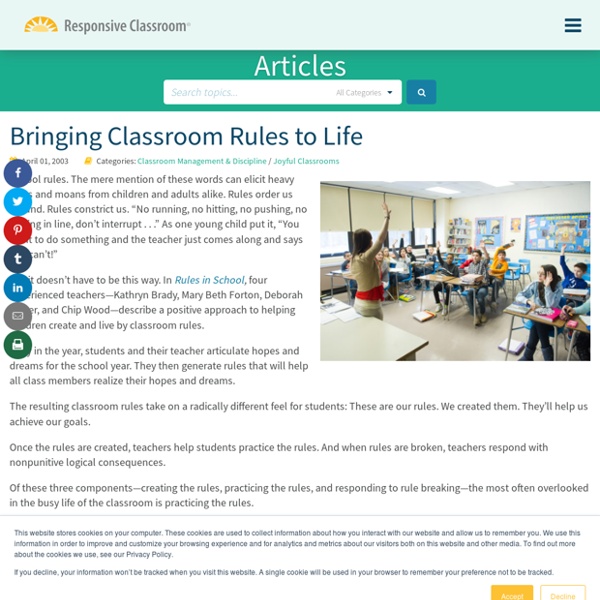Classroom Management Strategies for Elementary Teachers
Updated 01/2014 "With what are you struggling?" I ask. "I think I need some more direction on the little decisions like what do you do when a student complains about a stomach ache right before a lesson," replies student teacher.
Best Classroom Management Software in 2019
McGraw-Hill Education Connect is a robust toolkit of learning resources designed with the flexibility instructors need, to unlock the potential of a diverse student population. Connect provides opportunities for both formative and summative assessment. Our adaptive technology provides students with a safe place to make mistakes encouraging deliberate practice and enabling them to move one step closer to mastery.
15 creative & respectful ways to quiet a class -
Have you fallen into the trap of saying “No talking!” or “I need quiet!” all day long?
School Rules/Classroom Rules – Ms. Laura Carter – Bowers Elementary School
~Bowers School Rules~I am Respectful.I am Responsible.I am Ready. ~Classroom Rules~ #1 Students listen when their teacher/others are speaking. #2 Students follow directions first time given.
Elementary Classroom Management
3 Part Classroom Management SystemSubmitted by Maryann from Philadelphia I have a 3 part system. Whole group: for rewarding the class as a whole for behavior I put one marble in a jar every time the whole class has good behavior (example walking through the halls quietly). Then when the jar is full the class gets a cupcake party. Table groups: I have charts hanging up in the front of the room for table stars. I use it to get them to get all their books out quickly, keep the area clean, stay quiet, etc.
Classroom Management
More Articles of Interest CLASSROOM MANAGEMENT TIPS Differentiated Instruction, Flexibility Make Multi-Age Classes Work Multi-grade classes sound like a lot of work for teachers. But by regularly assessing students, differentiating instruction, and using flexible groupings, the experience can be revitalizing for a teacher. Included: Tips for planning lessons in multi-grade classes. Goal Setting Made Easy Teaching students how to set goals is easy with Goal Setting 101, a 3-part article that describes the process, and the Goal Tracker booklet, a student journal for recording goals and focusing on action steps.
Morning Meeting and Older Students
If you teach older students—those between 10 and 14—you may have wondered if Morning Meeting is appropriate for them. Can you spare the time from the intensifying academic focus in the upper grades? Do they really need the structure and support Morning Meeting provides? The answer is a definite Yes. Morning Meeting is not only appropriate for older students, it’s especially important as an anchor, a predictable routine that they need more than ever as they undergo rapid physical, emotional, and intellectual changes.
Elementary Classroom Rules and Management by Leah Davies, M.Ed.
By Leah Davies, M.Ed. Elementary classrooms can become better learning environments when teachers have rules, classroom management skills, and a belief that each child can be successful. Rules help create a predictable atmosphere that limit classroom disruptions and encourage children to use self-control. Children need to be taught that it is their responsibility to make appropriate choices and that they will be held accountable for their actions.
This ‘Kindness Curriculum’ Is Free And Should Be Used In Every Classroom
Imagine living in a world that valued kindness enough to teach it along with academics. Educators would teach kids to manage their emotions in addition to standard curriculum such as math and science. Sounds pretty amazing, doesn’t it? Well, the Center for Healthy Minds at the University of Wisconsin-Madison has created a free “kindness curriculum” for kids, designed to do just that. It’s a mindfulness-based curriculum for preschoolers that will bring kindness into the classroom.
What Is Classroom Management? A Guide for Newbie and Veteran Teachers
There are some topics that are so broad, so overwhelming that it’s hard to know where to begin. For teachers, classroom management can be one of those topics. It is a critical skill; some say it’s more important than content knowledge. And yet, there is no single method or protocol to follow to ensure success.
Mrs. Holowicki's Classroom Expectations, Rules, Procedures and Consequences
My Home Page » Mrs. Holowicki's Classroom Expectations, Rules, Procedures and Consequences Mrs. Holowicki's Classroom Expectations, Rules, Procedures and Consequences
Classroom Rules – Whole Brain Teaching
Use the same approach for Rule 3 as you did for Rule 2. Rehearse the rule, “Raise your hand for permission to leave your seat” with the hand gesture; students raise their hands, then walk their fingers through the air. Then, use Wrong Way-Right Way. Reynaldo, on your cue, leaves his seat without permission. Great job of breaking the rule. Reynaldo leaves his seat again, you call out Rule 3, and the kids exclaim, “Raise your hand for permission to leave your seat!”



